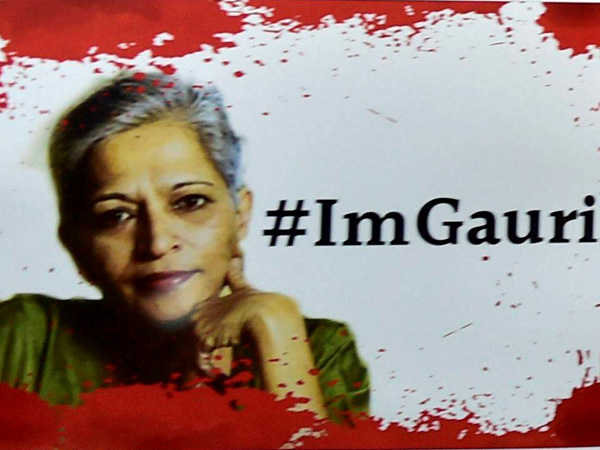1.7 crore calls analysed, 25,000 witnesses examined and Gauri’s killers are still at large
Gauri Lankesh was shot dead by unknown assailants on September 5 outside her residence in Bengaluru
Three months since senior journalist and activist Gauri Lankesh was killed by unknown assailants outside her home in Bengaluru, a Special Investigation Team (SIT) set up solely to investigate the crime has made little progress, at least when it comes to identifying (let alone nabbing) the culprits.
Senior police officials, directly involved in the investigation say that lack of technical evidence and eyewitnesses has become the bane of the probe.

The SIT has so far analysed 1.7 crore phone calls, interviewed and recorded statements of about 2,500 persons as witnesses, carried out physical verification of close to 40 suspects, interrogated around 250 persons and released three sketches--all of which has led to little progress. Four people who were a close match to the sketches were questioned, their antecedents verified and let off after the SIT ruled them out as suspects.
The lack of progress in the 30 August 2015 murder of rationalist thinker, M.M.Kalburgi in Dharwad, Karnataka and the 5 September killing of Lankesh, has put the respective investigating teams and the Siddaramaiah led Congress government in the state in the line of fire. But as senior police officials put it, the challenges have so far outweighed the evidence in the Lankesh case.
SIT's hurdles in Gauri Lankesh case
"These days, investigations are cracked by two things- technical details like calls or internet analysis and eyewitness account/motive. In this case, we have analysed about 1.7 crore phone calls but there is hardly anything that fits the description," a senior official directly involved in the investigation told OneIndia, requesting anonymity. The officer cited above added that mobile details are some of the top tools used by investigating authorities to crack crimes.
The officer added that while conventional policing is the foundation of any investigation, technical and technological analysis helps gain an advantage. "In this case, I think that the assailants refrained from using technology that could be traced. The lack of eyewitnesses on the day of the crime is another challenge," he added. The SIT is yet to identify the motive behind the murder- another hurdle in the investigation. "With such varied possibilities for motive, it is difficult to pinpoint and go on one line of investigation. We are falling back on basic policing and are hopeful of receiving some positive feedback. After all ground level policing is basic," the officer added.
S T Ramesh, former Karnataka DG and IGP, seconds this view and is in favour of a blend of both conventional and technical-technological investigating techniques.
"There is no set formula in investigations. Conventional steps of collecting evidence, studying crime scene, gathering ground intelligence through informants, medical evidence have to be relied upon when technical and technological information like CCTV footages, mobile phone call analysis are not available," said S T Ramesh.
"Clever criminals leave no trace"
While the SIT released CCTV footages purportedly showing Gauri's assailants, they have been of little help. "The assailants went untraced on CCTV after a point. They chose routes where there were no CCTV cameras that we could use to trace them," the officer said, hinting that the assailants had planned their sinister crime with a lot of care.
"A clever criminal never leaves clues either technical or traceable," is how S T Ramesh chose to explain the phenomenon of technological blank that the SIT is drawing in the Gauri Lankesh case. The inability to trace a criminal through mobile phone locations and call analysis proved a challenge for investigators in the infamous 2013 ATM attack case of Bengaluru and 2014 Church street blast case.
"Police have jurisdiction but criminals don't. Criminals can choose to strike whenever and wherever and police are reactive to the strike. Inadequate resources and high expectations are also a challenge. We are low on human resources, mobility, communication, financial resource, material resources and yet are expected to crack high profile cases," S T Ramesh added.
The former top cop highlighted that while some cases are cracked within hours, others, like the 2013 ATM attack case was time-consuming. "High profile cases like that of Gauri Lankesh that have political overtones put enormous pressure on the investigators. The people, victim's family, the media and political entities demand instant results but the police have to be patient. There can't be shortcuts," he said. The pressure, sometimes forcing investigators to show results, irrespective of how plausible they are.
The officer investigating the case reiterated on the need to stay focused. "We do not want to put the wrong person in jail and end up in a botched up investigation like what happened in the Haryana school murder case," he signed off.
OneIndia News


 Click it and Unblock the Notifications
Click it and Unblock the Notifications


































